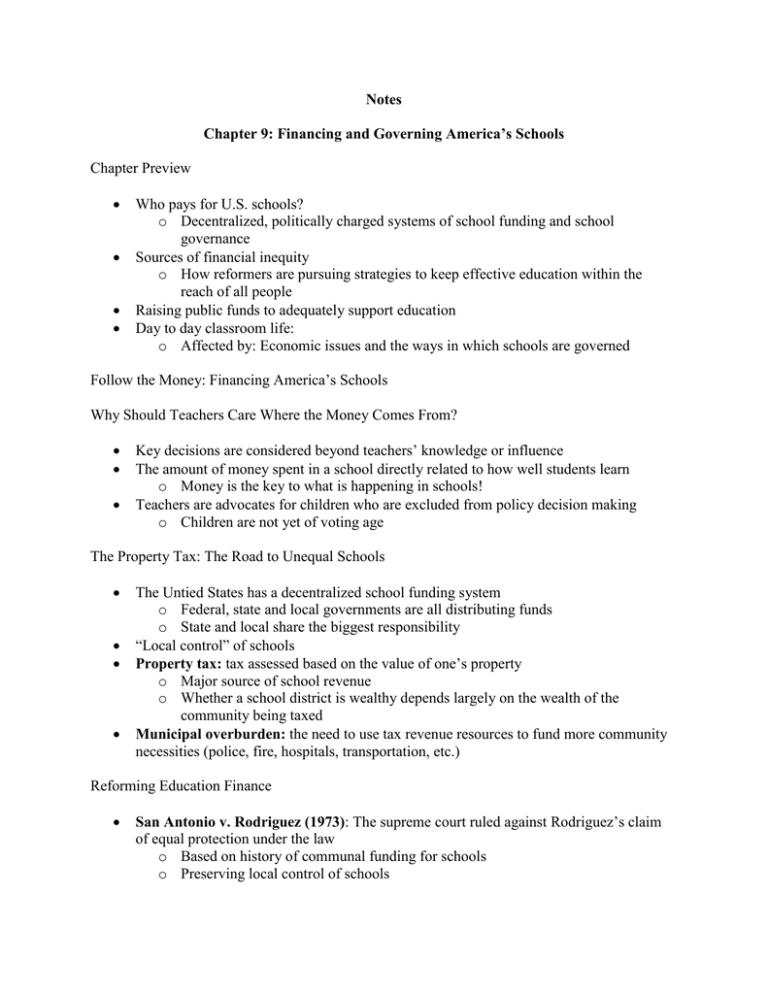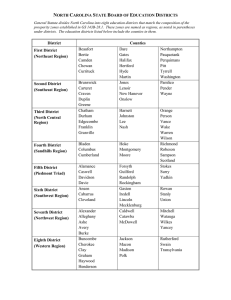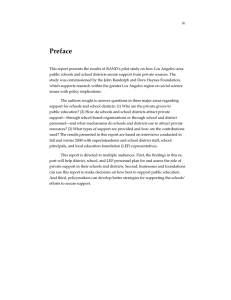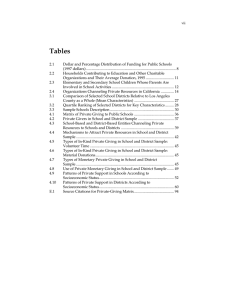Ch 9 Notes.doc
advertisement

Notes Chapter 9: Financing and Governing America’s Schools Chapter Preview Who pays for U.S. schools? o Decentralized, politically charged systems of school funding and school governance Sources of financial inequity o How reformers are pursuing strategies to keep effective education within the reach of all people Raising public funds to adequately support education Day to day classroom life: o Affected by: Economic issues and the ways in which schools are governed Follow the Money: Financing America’s Schools Why Should Teachers Care Where the Money Comes From? Key decisions are considered beyond teachers’ knowledge or influence The amount of money spent in a school directly related to how well students learn o Money is the key to what is happening in schools! Teachers are advocates for children who are excluded from policy decision making o Children are not yet of voting age The Property Tax: The Road to Unequal Schools The Untied States has a decentralized school funding system o Federal, state and local governments are all distributing funds o State and local share the biggest responsibility “Local control” of schools Property tax: tax assessed based on the value of one’s property o Major source of school revenue o Whether a school district is wealthy depends largely on the wealth of the community being taxed Municipal overburden: the need to use tax revenue resources to fund more community necessities (police, fire, hospitals, transportation, etc.) Reforming Education Finance San Antonio v. Rodriguez (1973): The supreme court ruled against Rodriguez’s claim of equal protection under the law o Based on history of communal funding for schools o Preserving local control of schools o The Supreme Court decided that it was the states’ responsibility to change the “local control” system It was not the federal government’s responsibility Serrano v. Priest (1971): CA Supreme Court-State’s financing system was determined to be unconstitutional o The property tax system violated equal protection under the law o “Districts with smaller tax bases cannot levy taxes at a rate sufficient to produce the revenue that more affluent districts produce with minimum effort” (353). Robin Hood reformers: people that took funds from wealthier districts and redistributed it o Programs to equalize funding o The minimums are far below what is spent o Wealthier tax payers became furious that their money was being transported from their children’s schools to poorer schools Guaranteed tax base programs: adds state funds to poorer districts o Helps reduce economic inequities o Is it unfair that wealthier districts aren’t receiving extra state funding? Tax dollars Robin Hood’s New Arrow: Adequacy Critics: evening with additional funding, the academic success of failing schools would not change o Redistributing tax dollars was politically unpopular and was ineffective Educational outcome versus Financial input o Student achievement versus per-pupil spending Adequate Education guarantees: ensure that all students have the basic skills they need to be effective citizen and compete in the labor market o Just get the basic skills? o What constitutes basic skills? Does Money Matter? Explanations of inequities in school funding Local Control: it was left to local communities in rural America to support their schools Horatio Alger: rags-to-riches: o American belief that wealth and success are the fruits of individual effort and that an individual’s circumstances are merely obstacles to be overcome. Genetics: Genetic differences have been used to explain why some succeed and some fail o Historically argued Culture of Poverty: some believe that poor people live in and are shaped by the problems inherent in impoverished communities o Such problems cannot be remedied through school funding Flawed Studies: 1960s study: school quality and funding has less of an effect on student achievement than family background or peer groups o School funding is unrelated to student achievement Previous Funding Increases Have Not Resulted in Achievement Gains: o Although education spending has increased, tests scores have not States Finding the Money Where does money come from to support schools o Sales tax: a change added to sales o Moving businesses to states with lower sales taxes Reduced the amount of revenue states earn o Personal income tax: brings in more than 25% of state revenue Not used in Texas Collected through payroll deduction A percentage of income (not a specific value amount) o State lotteries: Most states use lottery revenues to supplement parts of an established education budget (not fund education necessities) The Federal Government’s Role in Financing Education Economic gaps between states o Interstate inequity Federal government influences: o Categorical grants: funds directed at specific categories and targeted educational needs Preschool program funding (Head Start) Library construction Technology acquisition Veteran education opportunities Teacher and administrator training Educational research Free-lunch programs College loans o Block Grants: large sums of money that have great latitude in how they are able to be spent o United States Department of Education: Raising federal involvement in education Influences schools by conducting research, publishing information, proposing legislation and disbursing targeted federal funds What the Future May Hold for School Finance We are in a period of shifting governmental responsibility Reformers are focusing less on financial inequity and more on educational inadequacy Accountability The public wants to see academic progress for their tax dollars Student and educator testing Graduation based on performance Identify specific goals for schools o Responsible for reaching said goals Choice Programs Reformers are promoting business culture and the value of competition as they keys to school improvement The Economy’s Impact on School Budgets State and local budgets are cut when the economy is not doing well Fewer employed teachers Larger class sizes Elimination of sports and extra-curricular activities End school years earlier Local Fundraising Wealthier districts are coming up with other ways to work around funding redistribution o PTA donations o Online fundraisers o Cooperative agreements with local businesses o Tax-sheltered private education foundations Brings money for technology, science equipment, devices for special needs students, college scholarships Decaying Infrastructure Repairing versus replacing older schools buildings o Cheaper! Dept. of Education estimates that 25,000 schools need major repairs Bonds o Give local communities the money they need to build the schools and 15-20 year to pay it off Governing America’s Schools The Legal Control of Schools School boards: determine educational policy and their members tend to be male, Caucasian and over 50 years old o Similar to government leaders o Appointed versus elected leaders (depends on the state) In Texas: elected Vote: They are very influential and determine monies spent on school districts! State Board of Education: responsible for formulating educational policy o Members are usually appointed by the governor o Some are elected state-wide Chief State School Officer: Superintendent: responsible for overseeing, regulating and planning school activities, as well as implementing the policies of the board of education o Usually selected by the board of education o Sometimes elected State Department of Education: performs the administrative tasks needed to implement state policy o Licensing teachers, testing student progress, providing information and training to teachers, distributing state and federal funds, overseeing that districts are complying with laws, conducting educational research School Districts-Local School Boards and Superintendents o Handles local school operations o May be responsible for: School construction, taxing, budgeting, hiring school personnel, curriculum decisions, local school policy o Must operate within the rules of the state State Influence Grows as School Boards Come Under Fire Arguments against school boards: o Become immersed in administrative details o Not representing local communities o Politics of school board elections o Do not support current educational reform proposals o Too limited in scope to respond to all contemporary concerns of children Health, social, nutritional o If financed less from local funds and more from state funds they will be less influential o Call for new governance organizations Make the school board less important or unnecessary The School Superintendent and Principal Superintendents: expected to supervise and hire teachers, examine students and buy supplies, kept school records, developed exams, chose textbooks and trained teachers o Because it was too burdensome for school boards Now considered to be the educational expert Always trying to please various groups and communities o High visibility, high stress Covert Power in Schools Covert Power Unofficial, highly powerful groups of people o Parents, school secretaries, community groups Hidden Government of schools Business and Schools Business values are influential in school practices o Often mirror business values Hard work, competition, dependability, punctuality, neatness, conformity and loyalty Educational Partnership: companies that formalize relationships with schools o Dedicated personnel or products or exclusive rights contracts (Ex: Coca-Cola) Making Schools More Responsive Teachers have often been removed from involvement in school governance o Many crucial decisions are made by outsiders o Feeling of teacher powerlessness Site-based or school-based management shifts decision making from the central district office to individual schools Collaborative decision making: creates teacher committees to share power between principal and faculty Faculty may not feel comfortable coming forward Yet another thing teachers “have to do” versus enjoyment of participation in decision making Consolidation: Merging smaller schools and districts into larger ones o More red tape, greater, student alienation, reduced parent-teacher involvement o Less responsive schools Decentralization: Creating smaller schools and smaller districts



